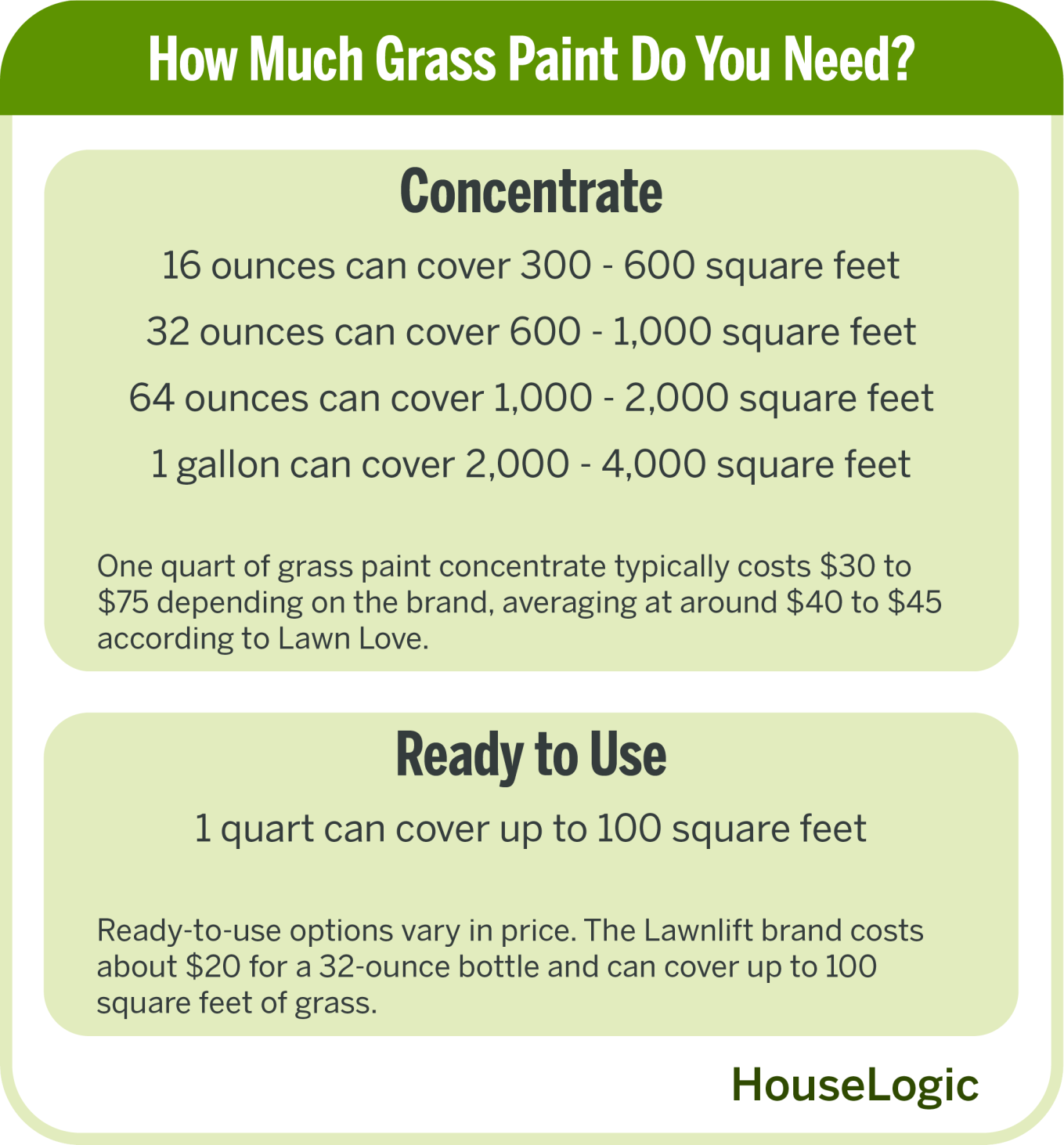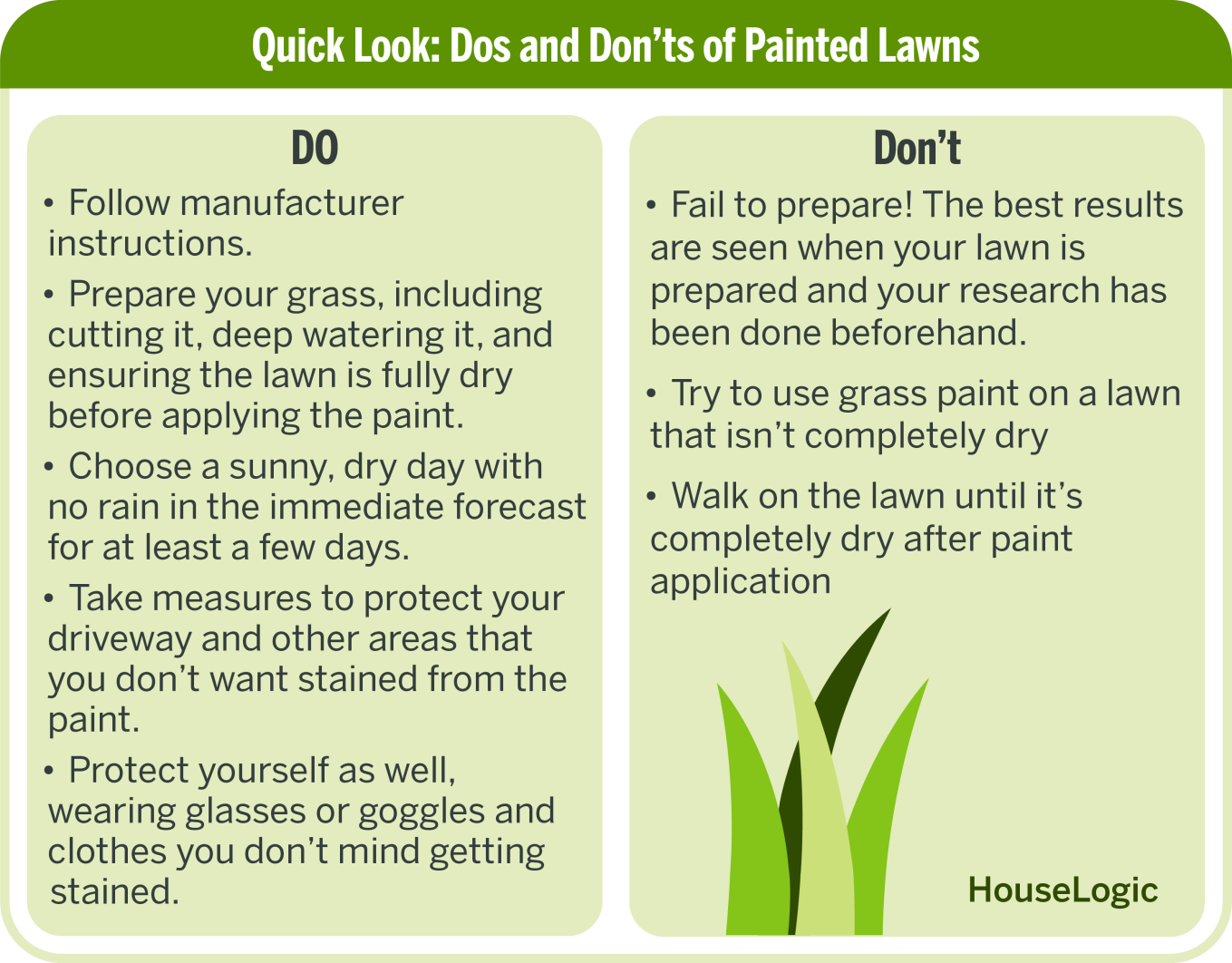When it comes to curb appeal, nothing beats a beautiful green lawn adorned with a smattering of flowers, the shade of an oak, or a raised bed full of edible plants. Keeping a lawn green, though? That’s another story. In droughts, snow, or hot, southern summers, lawns require more maintenance, and lush, healthy grass can easily turn dry and brown. Grass painting to the rescue.
Better known as colorant, grass paint is an easy, eco-friendly way to restore life to a lawn that’s lost its luster. We’ll cover what grass paint is (and is not), considerations in choosing products, and tips for painting a lawn.
What is Grass Paint?
In the lawn and garden world, grass paint goes by other names, such as grass colorant or turf paint. It’s a nontoxic, water-based product that acts as a stain, and it’s formulated specifically for grass. That means it won’t cause the issues that regular paint would. Grass paint is made up of these four components:
- Pigment — provides the green color
- Binder — helps the pigment stick to the grass
- An additive — is typically some kind of thickener, emulsifier, or other ingredient that helps the product mix well or spread evenly across the lawn, according to the N.C. Cooperative Extension office.
- A solvent — is water, in most cases, and brings everything together
“The colorant lasts from about three months to six months, depending on how often the lawn is cut,” says a corporate marketing associate with Green Canary, a lawn colorant company based in California.
Using grass paint rather than overseeding works for a number of reasons, one of which is cost. Grass paint is often cheaper than extensive fertilization or overseeding. “For some people, painting over a large brown spot in your yard is easier,” says Tom Smith, owner of Desert Designer Landscape and Development in Chandler, Ariz. “It is an option to keep your yard green while the grass is not growing in the winter. It is also an option for areas that aren't getting any sun, such as a brown patch behind a tree."
Grass Paint vs. Regular Paint
Grass paint is a lawn-specific formula that’s safe for pets and people and that doesn’t have some of the drawbacks of regular paint.
Here are three reasons you shouldn’t use regular paint on grass:
- It’s made of chemicals that could be toxic and contaminate a lawn or water supply because of runoff.
- It will break down in harsh weather or rain, so it won’t last as long as grass paint, which is formulated for longevity.
- It contains harsh chemicals that might harm children and pets.

Environmental Impact
Homeowners who do a little research will likely find grass painting can be an environmentally responsible choice. Most grass colorants on the market are made of biodegradable materials that won’t harm the environment, pets, or people, especially after the colorants have fully dried. Before choosing a grass paint brand, make sure it has been tested for safety and the ingredients are biodegradable. The label should read that the product is “pet-friendly,” “eco-friendly,” or “nontoxic.” You can also check the ingredients list to make sure the ingredients are biodegradable. If you’re still not sure about the product, ask a salesperson.
If you’re looking for an option that’s lower-maintenance than grass painting and environmentally friendly, you might consider artificial turf.
Why Should You Paint Your Lawn?
Most people who invest in grass value the aesthetic a green lawn provides. Keeping a lawn green requires maintenance, though, and sometimes it’s hard to keep up with. Brown patches or a dead lawn will ruin that aesthetic value, but grass paint can keep the lawn looking green and fresh.
Grass paint can also help reduce water usage, a benefit for homeowners interested in conserving water. It’s often used on northern grasses, also known as “cool season” grasses, like Kentucky Bluegrass and Bentgrass. These grasses prefer climates with a cold winter and a hot summer, but hot summers mean more water. Grass paint offers a way to keep the grass looking green in the summertime while reducing watering.
Cost savings is another factor that often attracts homeowners to grass paint, because the option reduces the need to fertilize or overseed.
Types of Grass Paint and How to Choose
Grass paint comes in two forms: concentrate and ready to use. The concentrate option is great if you’re planning on spraying an entire yard or a large piece of land. One 16-ounce bottle of concentrate, for example, can cover approximately 300 square feet to 500 square feet of lawn. The ready-to-use option is best for covering small areas like brown patches.
What to Consider When Choosing Grass Paint
When choosing grass paint, you’ll need to consider factors such as:
Type: Concentrated vs. ready-to-use grass paint — First, you’ll want to determine whether you need a concentrate or a ready-to-use paint. This will depend on the amount of square footage you plan to cover with the colorant and ease of use.
Here’s information about how much concentrate you might need and the costs of both concentrate and ready to use.

Lawn size — The concentrate is more effective for larger areas, while the ready-to-use option, though more expensive per ounce, might be better for spot treatments. Additionally, the ready-to-use option is more convenient.
Color preference — Different grass paint pigments are available to match different kinds of grass. You’ll want to choose one that best complements your grass and consider whether you want to enhance the color you have or cover a brown patch. This will determine the kind of application you need.
Length of use — Some grass paints, like Green Canary, are developed to last for a few months to several months; others, like Endurant Turf Enhancer, are better for shorter-term use. If you want just a pop of color for a gathering or an event, a shorter-term option might be best; a long-term option would be good for the summer season.
Drawbacks — While grass paint is considered nontoxic, you should take precautions to avoid ingesting it or getting it on clothing while wet, because it stains. Also, spraying an unhealthy lawn with grass paint is a short-term fix and doesn’t repair the yard. If your lawn has high-traffic areas that are also unhealthy, grass paint won’t solve the problem. The N.C. Cooperative Extension office notes: “Once the dormant tissue (of the grass) is worn or torn away, no regeneration occurs until spring.” That means it would also be difficult to reapply grass paint to the area, because there will be no grass to speak of.
How to Paint Your Lawn
Painting your lawn will take some preparation for the best results.
Prepare the Grass
“Mow the lawn, remove any debris around the yard, water deeply, and wait for the yard to dry before applying the grass,” Smith says. “Block off the entire area around the yard with cardboard to avoid getting it on your nongrassy areas.” The product stains concrete, so you’ll also want to cover driveways, sidewalks, or other surfaces that you don’t want stained.
Monitor the weather to ensure a sunny, dry day. Grass paint takes several hours to dry completely, so you’ll want to make sure the weather won’t interrupt the process.
To make the paint last longer or reduce prep time, a low-level grass or “no mow” grass, which doesn’t require mowing, might also help, if you’re starting from scratch.
Apply the Paint
Now that the grass is prepped and you’ve chosen a dry, sunny day, it’s time to paint. The ready-to-use options don’t require any mixing or combining. For the concentrate option, you’ll need to follow the mixing instructions. For both options, make sure to follow manufacturer directions.
To apply the paint, you’ll need some equipment, including:
- A pump sprayer
- The grass paint of your choice
- Water
A backpack configured to hold large amounts of grass paint is useful when covering large areas.
You’ll also want to keep safety in mind. Grass colorant shouldn’t be inhaled. While applying it, consider:
- Wearing a mask
- Covering up with other items, like gloves, boots, and long pants, that protect the skin
- Choosing protective eyewear like sunglasses or goggles
“Then carefully apply the area in straight lines as if you were mowing your lawn. Allow time to dry and do it on a nice sunny day,” says Smith.
It’s also a good idea to apply the colorant in multiple directions so you don’t end up with streaks.
Post Application Care
After you’ve applied the grass paint, keep pets and people off the area until the colorant dries. Most grass paint brands advise a dry time of 24 to 48 hours. The Green Canary representative says they advise waiting a little longer, just to be sure. “We sometimes tell people 72 to be safe.”
If you discover a spot that doesn’t have the hue you desire or you’ve missed a spot, simply go back in and reapply after the rest of the grass paint is dried. To keep your yard looking as green as possible, consider reapplying the grass paint more frequently than recommended. You might also want to reapply more often if you mow your grass frequently.
Do’s and Don’ts for Quick Reference

FAQs: Painting Grass
How Long Does Lawn Paint Last?
This depends on the brand, the weather, and lawn traffic. You can usually count on grass paint lasting a couple of months. Green Canary says their products have built-in weatherization that can last up to six months as a result.
Other considerations include weather. Grass paint lasts longest in areas with mild weather, so if you’re experiencing a harsh season or a lot of rain or snow, the paint might not last as long.
Can You DIY a Grass Painting Project, or Do You Need a Professional?
For smaller yards or the painting of brown spots, DIY is completely doable. Larger yards or properties with lots of acreage might require professional assistance. Green Canary advises homeowners who have a landscaper or gardener to consult with them about assisting on the project.
Does Rain Wash Away Grass Paint?
Grass paint is formulated to withstand standard rainfall. That said, rainfall can wash away the paint if the rain is particularly heavy or prolonged. Additionally, it is important to understand that the paint must be fully dried for it to hold up against rain.
Is Lawn Paint Toxic for Pets and Children?
You might be worried about whether grass paint is safe for pets and children, especially since the lawn is often a place where pets and kids like to play. Reputable, well-tested products are made to be safe for pets and children. This is because they are formulated with biodegradable, eco-friendly materials. They are also safe for use on healthy grass.
